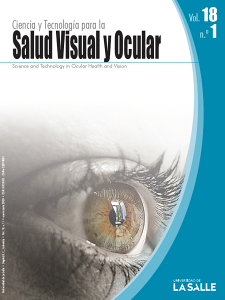##article.abstract##
<p>El trastorno del espectro autista (TEA) se caracteriza por una alteración generalizada del desarrollo cerebral, que afecta la socialización, comunicación, imaginación y reciprocidad emocional y se evidencia mediante conductas repetitivas e inusuales. El uso de prismas gemelos estimula una reorganización neurológica y provoca cambios en la percepción visual. El objetivo del presente artículo fue evaluar las habilidades visuales y determinar el efecto de los prismas gemelos en la atención, postura y comportamiento de los niños con TEA. Se elaboró un estudio de intervención con muestras pareadas antes-después; se incluyeron 20 niños con diagnóstico de TEA en edades de 4 a 16 años, y se realizó una evaluación optométrica basal, aplicando un cuestionario para identificar síntomas y otra posterior al uso de un anteojo con prismas base superior, durante 4 meses. El análisis estadístico se realizó con prueba t de Student para muestras no independientes. Se halló que la media de edad fue de 10,05 años, 90 % sexo masculino, 45 % hipermetropía, 30 % insuficiencia de convergencia, 90 % fusión y 85 % estereopsis gruesa. El promedio de aciertos en el cuestionario inicial fue de 18,50 ± 7,64 y en el final de 13,20 ± 7,53 p = 0,000. Finalmente, se concluye que la hipermetropía se presenta en el 45 % de los casos; un 30 % presenta insuficiencia de convergencia, y el 85 %, estereopsis gruesa; asimismo, el uso de prismas gemelos de 3 dioptrías base superior produce cambios estadísticamente significativos en la postura, atención y comportamiento, por lo que se propone como alternativa de manejo adicional en niños con TEA</p>##submission.citations##
Kaplan M. Seeing through new eyes. Philadelphia: Jessica Kingsley Publishers; 2006
Developmental Disabilities Monitoring Network Surveillance Year 2010 principal investigators; Centers for Disease Control and Prevention (CDC). Prevalence of autism spectrum disorder among children aged 8 years - autism and developmental disabilities monitoring network, 11 sites, United States, 2010. MMWR Surveill Summ. 2014;63(2):1-21
Karande S. Autism: A review for family physicians. Indian J Med Sci. 2006;60(5):205-15. doi: 10.4103/0019-5359.25683
Lemer P. Outsmarting Autism, The Ultimate guide to management Healing and prevention. United States of America: North Atlantic Books;2014
Rose M, Torgenson N. A Behavioral approach to vision and autism. Journal o0f Optometric Vision Development. 1994;25(4):269-275
Harris, PA. The behavioral use of prisms. In: Barber I. Vision Therapy. Tools of Behavioral Vision Care: Prisms. Maryland: Optometric Extension Program; 1996
Crottaz-Herbette S, Fornari E, Clarke S. Prismatic adaptation changes visuospatial representation in the inferior parietal lobule. J Neurosci. 2014;(34)35:11803-11. doi: 10.1523/JNEUROSCI.3184-13.2014
Errington JA, Menant JC, Suttle CM, Bruce J, Asper LJ. The effects of vertical yoked prisms on gait. Invest Ophthalmol Vis Sci. 2013;54(6):394956. doi: 10.1167/iovs.12-10955
Kaplan M, Edelson SM, Seip JA. Behavioral Changes in Autistic Individuals as a Result of Wearing Ambient Transitional Prism Lenses. Child Psychiatry Hum Dev. 1998;29(1):65‐76. doi:10.1023/a:1022635314597
Sheiman M. Wick Bruce Clinical Management of binocular vision. Heterophoric, accommodative and eye movement disorders. 4th Edition. United States of America: Lippincott Company; 2014
Sonisha N, et. Al. Ocular Morbidity in children with autism. O &VP 2013; 1(1) 32-42. https://www.oepf.org/sites/default/files/OVP1-1_article_Bhandari_web.pdf
Sharre JE, Creedon MP. Assessment of visual function in autistic children. Optom Vis Sci. 1992;69(6):433-9. doi: 10.1097/00006324-199206000-00004
Pokharel, Pokharel PK, Das H, Adhikari S. The patterns of refractive errors among the school children of rural and urban settings in Nepal. Nepal J Ophthalmol. 2010:2(2):114-20. doi:10.3126/nepjoph.v2i2.3717
Kemmer C, Verbaten MN, Cuperus JM, Camfferman G van Engeland H. Abnormal saccadic eye movements in autistic children. J Autism Dev Disord. 1998:28(1):61-7. doi: 10.1023/a:1026015120128
Rosenthall U, Johansson E, Gillberg C. Occulomotor findings in autistic children. J Laryngol Otol. 1988;102(5):435-9. doi: 10.1017/s0022215100105286
Takarae Y, Minshew NJ, Luna B, Sweeney JA. Oculomotor abnormalities parallel cerebellar histopathology in autism. J Neurol Neurosurg Psychiat. 2004;(75(:1359-61
Milne E, Griffiths H, Buckley D, Scope. A. Vision in children and adolescents with autistic spectrum disorder: evidence for reduced convergence. J Autism Dev Disord. 2009; 39(7):965-75. doi: 10.1007/s10803-009-0705-8
Denis D. Burillon C, Livet MO, Burguière O. Signes ophtalmologiques chez l'enfant autiste [Ophthalmologic signs in children with autism]. J Fr Ophtalmol. 1997;20(2):103-10
Barret BT. A critical evaluation of the evidence supporting the practice of behavioral vision therapy. Ophthalmic Physiol Opt. 2009;29(1):4-25. doi: 10.1111/j.1475-1313.2008.00607.x
Suttle CM, Asper LJ, Sturnieks DL, Menant JC. Negligible impact on posture from 5 diopter vertical yoked prisms. Investigative Ophthalmology & Visual Science. 2015;56(5):2980-4. doi:10.1167/iovs.14-15866
